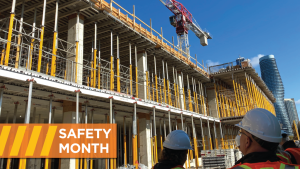Workplace Safety and Insurance Board (WSIB) president and CEO Tom Teahen has promised ICI stakeholders the board will keep a close watch on health and safety statistics for the sector after the new WSIB rate framework regime launches in January.
And if the stats continue to show the ICI sector works more safely than low-rise residential, Teahen told delegates attending The Buildings Show CEO Breakfast in Toronto Dec. 5, the WSIB will be open to separating the two sectors into different rate classes, meaning premium savings for ICI contractors.
Teahen participated in a panel session with questions posed by Ian Cunningham, president of the Council of Ontario Construction Associations and John Mollenhauer, president and COO of the Toronto Construction Association.
“As the model continues to evolve, we will see groups within each class start to take on different profiles,” Teahen said. “When we originally formed that class, the experience between those two classes were pretty close. And you are right, I think over the last couple of years we have seen some evidence that the risk profiles are diverging.
“I have committed to them (ICI stakeholders) to say, we will look at that this year, and if we continue to see that trend, or in any other sector, we will look at the classes and be open to making modifications,” said Teahan.
In fact, according to David Frame, director of government relations for the Ontario General Contractors Association, the WSIB has tentatively committed to making changes to the G1 rate class for 2021.
“We have been working on this issue for well over three years now,” said Frame recently. “Early this year we got agreement from the WSIB that based on the current trends, if they are sustained, they would make those changes effective 2021.”
There were three consistent years of data from 2015 to 2018, the latest year available, that showed the change should be made, said Frame, but last January the WSIB told him it was unable make the change at that time.
Data from the 2019 WSIB Premium Rates Manual shows that rate group 764, the homebuilders group in the former system, had a 1.80 per cent lost-time injury (LTI) rating in 2018, up from 1.73 in 2012. The ICI sector, until now in rate group 723, had a 0.69 per cent LTI rating in 2018, down 34 per cent from 2012.
“There continues to be an increasing gap between the residential side and the ICI side, and based upon that we are anticipating the changes will be made in 2021,” said Frame.
Under the new rate framework model, construction companies will be grouped into five classes rather than the previous 13 rate groups. The new G1 class containing both the low-rise residential sector and the ICI contractors will have an average premium rate of $2.30 — a charge Frame, Cunningham and Mollenhauer argue is unfair for their contractors because it represents the pooled risks of the safer ICI contractors combined with the riskier low-rise residential.
Cunningham and Mollenhauer welcomed Teahen’s assurance the WSIB would keep its eyes focused on the LTI discrepancy as the new rate framework regime gets established.
“If they will try it for a couple of years and if their experience shows it should be different and they make the change, that doesn’t sound unreasonable,” said Cunningham. “Tom will be reminded of his commitment to make a change if a change should be made.”
Commented Mollenhauer, “I think the good news is the WSIB is listening and I think the truth is that the data supports that ICI general contractors have a better risk profile than residential low-rise so it makes sense to me that they be separated, not combined.
“I believe Tom when he says the WSIB is listening and paying attention and recognizes that there are tweaks that need to be made and that it’s a process not an event and it will take time to get things right.
“I think they have a proven track record and they are true to their word and they are paying attention.”
Teahen said in an interview after the Buildings Show session that he would not commit to a time frame for reforming the G1 rate class.
“I can’t tell you the time frame for ICI and residential, other than that the issue has been flagged for me so we are paying attention to that so we will see what happens,” he said.
Frame noted the reclassification issue is complicated by the fact that not all ICI contractors nor residential low-rise contractors were assigned to G1 so there is not a perfect match for studying data. The rate-class premiums are not based on LTIs but rather on costs associated with LTIs, which he said further favours the ICI contractors.
He said he has written to the WSIB asking for a meeting early in the new year to discuss the 2021 target. Recommendations by the WSIB would go to the minister of labour who would have to make a change to the WSIB regulations.
Frame said the expectation is that there would be a new rate class created, G6, into which either the ICI contractors or the low-rise residential contractors would be assigned.











Recent Comments
comments for this post are closed